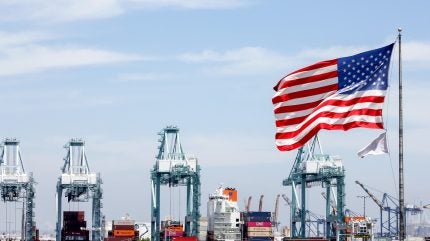
According to the latest Global Port Tracker report, a collaborative effort between the National Retail Federation (NRF) and Hackett Associates, revealed that in December 2024, US ports processed approximately 2.14m twenty-foot equivalent units (TEUs), exhibiting a robust 14.4% year-over-year growth.
This performance marked a slight decrease from November and contributed to an annual total of 25.5m TEUs for 2024, an increase of 14.8% from the previous year and just shy of the record set in 2021 during the pandemic.
NRF supply chain and customs policy vice-president Jonathan Gold said: “Supply chains are complex. Retailers continue to engage in diversification efforts. Unfortunately, it takes significant time to move supply chains, even if you can find available capacity. While we support the need to address the fentanyl crisis at our borders, new tariffs on China and other countries will mean higher prices for American families.
“Retailers have engaged in mitigation strategies to minimise the potential impact of tariffs, including frontloading of some products, but that can lead to increased challenges because of added warehousing and related costs. We hope to resolve our outstanding border security issues as quickly as possible because there will be a significant impact on the economy if increased tariffs are maintained and expanded.”
The urgency for retailers to import goods has been fuelled by several factors, including the possibility of a port strike along the East Coast and Gulf Coast in January and the anticipation of tariffs announced by US President Donald Trump.
Trump imposed 25% tariffs on most goods from Canada and Mexico, and 10% on goods from China, a measure cited as necessary to combat the threat of illegal immigration and drugs, including fentanyl.
Trump’s tariffs on Canadian and Mexican goods are briefly suspended, however the 10% levies on Chinese imports remain in place.
According to Hackett Associates founder Ben Hackett, the initial tariffs on Canada and Mexico might not significantly affect port activity due to the prevalence of land-based transportation for these imports, a shift could occur if tariffs influence goods that undergo final manufacturing in these countries but originate elsewhere.
A broader imposition of tariffs on Asian and European imports could adversely affect port cargo volumes if consumers respond by reducing their purchases due to higher prices.
“At this stage, the situation is fluid, and it’s too early to know if the tariffs will be implemented, removed or further delayed. As such, our view of North American imports has not changed significantly for the next six months,” Hackett added.
Looking ahead, projections indicate continued vigour in import volumes with February expected to see a marginal year-over-year increase despite being historically slow due to factory shutdowns for Lunar New Year celebrations in China. The forecast extends into mid-2025 with varying degrees of growth anticipated for subsequent months.



